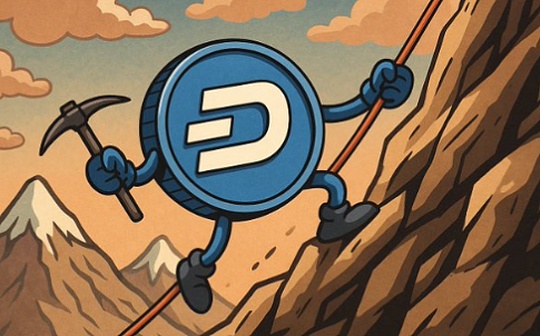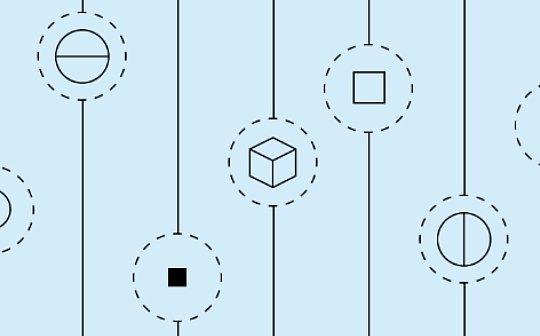
Author: Zack Pokorny, Galaxy; Compilation: Baishui, Bitchain Vision
summary
In our 2025 cryptocurrency and Bitcoin forecast, we point out that DAO (Decentralized Autonomous Organization) will begin experimenting with Futarchy in its governance process.This view is based on the success and size of the Polymarket election market, which proves that forecasting markets are more accurate, responsive, and more democratic than centralized voting venues.We have seen multiple advances at Futarchy and there is growing interest in the forecasting market.This article explores the latest developments and status of Futarchy/DAO governance and on-chain forecasting markets.
What is Futarchy?
Futarchy is a governance system that, like democracy, allows anyone to express their own opinions; however, it separates the process of setting goals from the process of evaluating means to achieve them.In traditional democracy, voters usually vote on votes that reflect their values and beliefs.When voters choose candidates or vote on policies, they usually express what they value (such as fairness, economic growth, or social justice) and what they believe is best to achieve these values (based on their assessment of candidate competence or policy effectiveness).This is in stark contrast to Futarchy, where individuals vote for goals based on their own values, and the forecasting market (or “bets”) is used to measure the most effective means of achieving these goals.This effectively separates the evaluation part from the prediction part (i.e. the result).Futarchy’s main advantage is that it uses the predictive power of financial markets and asset prices to guide decisions, with participants placing real currency bets behind their predictions.This market-based approach combines accurate predictions with rigorously analytical incentives, which is often impossible for free ballot box voting.
On-chain forecast market status
Polymarket’s holdings in pending markets (the value of the active markets on the app) dropped sharply after the U.S. election, falling from $512 million at its peak to $113.2 million today.Although large amounts of positions have been withdrawn from the app, usage has since remained stable and above pre-election levels.
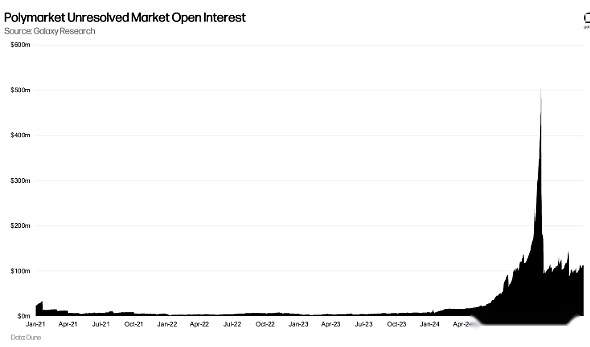
The transaction volume of tokens was also higher than pre-election levels, with monthly trading volumes of $835.1 million as of the end of February.Although monthly trading volumes fell 68% from election month highs, they were still 23% higher than the average in the first six months of the election, including October 2024 and 57% higher than the monthly trading volume in September 2024.It is also worth noting that DeFi activity has generally been declining since its December 2024/early January 2025 high.Therefore, the growth of Polymarket open interest contracts and slow trading volume may be the result of increased market power.
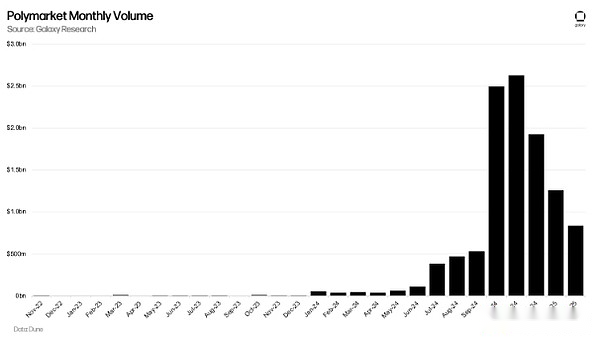
A significant area of growth in Polymarket is the number of monthly “initialization issues” (also known as markets) on applications.The increase in market volume, while expanding the subjects and events available for betting, may also be a factor in the decline in trading volume and open contracts, as market oversaturation can weaken the network effects of a few concentrated markets when activity decreases.
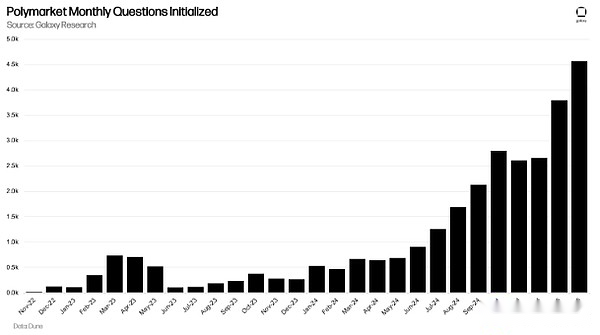
Futarchy on-chain status
While Polymarket’s activity has significantly declined from the highs of election fanaticism, the inertia of its success is emerging throughout DAO governance.Futarchy’s most scrutiny in on-chain governance is focused on Solana, and most of the discussion and implementation of the concept is conducted by the Solana community and the Solana chain.In addition to Optimism running the test market on total application value lockdown, joint funding from Optimism and Uniswap Foundation has led some early initiatives to explore Futarchy in the Ethereum ecosystem.
MetaDAO
Solana’s MetaDAO is the first large-scale implementation of Futarchy in the field of governance, providing DAO with a platform for launching the Futarchy marketplace and user participation in voting.Since its launch in November 2023, the platform has contributed to 62 Futarchies in nine DAOs, including itself, with 19 of them completed after the election.Three of the largest Solana-based DAOs (Jito, Marinade and Sanctum) have completed their first Futarchies after the election, and Sanctum resolved four decisions through the Futarchy vote.It is worth noting that Sanctum, along with Ore, adopts MetaDAO as its primary platform for governance operations, is fully committed to Futarchy.
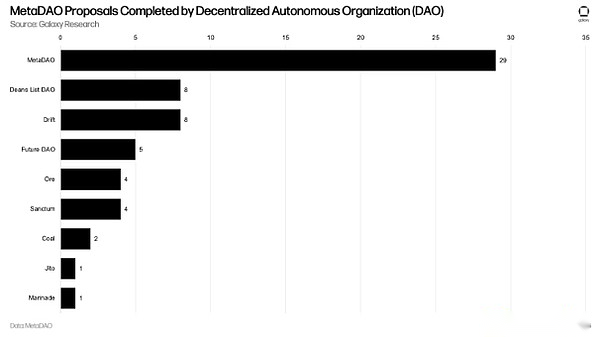
Sanctum attracted 1,648 independent voters despite only four votes.That’s more than the four proposals Lido and Ethereum Domain Name Services (ENS) received in 2024 with independent voters.However, speculation about the app’s second season airdrops and other incentives could distort that number.In other DAOs, the number of participants remains small, which can be partly attributed to their experiments with Futarchy while maintaining the traditional governance voting process.
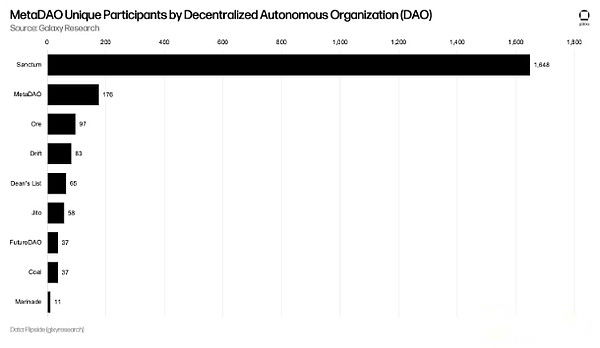
Under the Futarchy system, the voting process is a market.Therefore, tracking swaps and swap volumes provides additional measures of participation.Since the launch of MetaDAO v2 in May 2024, the platform’s Futarchies has generated $2.26 million in cumulative transaction volume.Of this, $902,600 (40%) was executed after November 1, 2024.
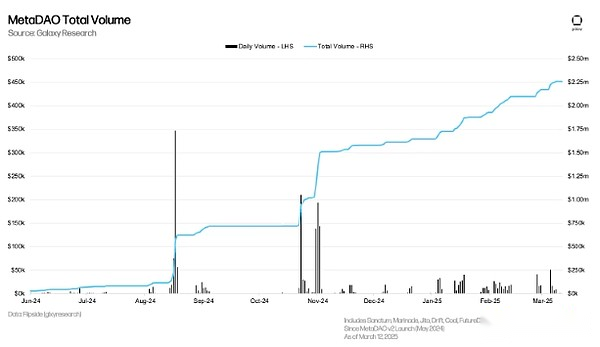
This volume was conducted through 10,318 transactions across all Futarchies.Since MetaDao v2 went live, this means about $219 per vote, and 246 votes per Futarchy.For reference, Aave and Uniswap averaged over $450,000 per vote in 2024, with more than 600 votes per proposal.Therefore, while Futarchies has fewer vote actions per proposal, the lower dollar value per vote action indicates that smaller participants gained greater influence in the voting results.
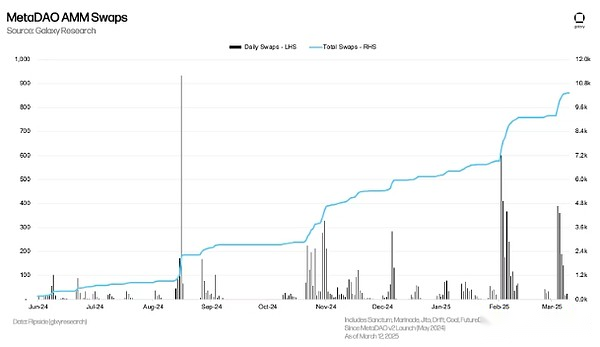
Futarchy Beyond Solana
Futarchy’s experiments also extend to Ethereum and its layer 2 (L2).Optimism and Uniswap Foundation announced a joint program to experiment with forecasting markets within their governance framework, and Uniswap announced its first implementation of futarchic governance on Unichain, centering on grants to lending applications.The deadline for applying for grants for loan applications is February 21.It is not clear when this particular Futarchy will be conducted.
Optimism also launched a Futarchy competition on March 10 and offers OP token rewards.The contest is powered by simulation tokens, allowing users to vote on changes in the total lock value (TVL) of applications on the hyperchain (a general term for chains developed on the OP technology stack).Users can vote for or against based on how they think the app’s TVL will move.Users who vote correctly will receive an OP token reward on the resolution date of June 12, 2025.
New Use Cases and Extensions Futarchy
MetaDAO recently passed the launchpad, which provides DAO with a unique opportunity to launch more seamlessly in the form of Futarchies and to try to address the capital/trust paradox that plagues projects and early investors.The launchpad will initially be licensed at testing, but the proposal points to a long-term plan, even if the generation of Futarchy DAOs is launched without permission.
This launchpad model is good for projects because they raise funds and build communities before tokens are generated and can be launched in the form of Futarchy from day one.It provides an out-of-the-box solution for launching DAOs and tokens, making Futarchies easier to form.One persistent problem with existing DAOs with Futarchy is the migration from its legacy governance system, which includes 50/50 Futarchy/traditional governance.Migrating to a full Futarchic model can confuse users and negatively impact Futarchy participation – launching in the form of Futarchy on the first day can help drive participation.
The launchpad model is better for investors because the portion of their contributions translates into the initial liquidity of the token, and the funds are locked in Futarchy and require community consent to be unlocked.In this case, the capital they contributed enhances the on-chain liquidity of their investments and the founding team cannot use pre-raised funds at will.At any time, the community can collectively agree to press the pop-up button to return the funds to the former investor of the token.
Mtndao will be the first Futarchy to be launched through the MetaDAOs launchpad.The token sale is scheduled to take place around the week of March 31, 2025, and the specific start date is yet to be determined.Token sales are expected to last about a week.
in conclusion
There is an increasing interest in using Futarchy to improve DAO governance.Polymarket’s success has raised questions about how the model can bring benefits to decentralized organizations.As many cryptocurrency users believe that the existing DAO governance is fragmented and needs to be subverted, Futarchy emerged as a promising alternative.Although its initial implementation was primarily on Solana, its iteration on Ethereum will allow for valuable comparisons with the traditional DeFi DAO governance model.Additionally, new developments like the MetaDAO launchpad can make the Futarchy model more scalable and allow new DAOs to choose from it from day one.

